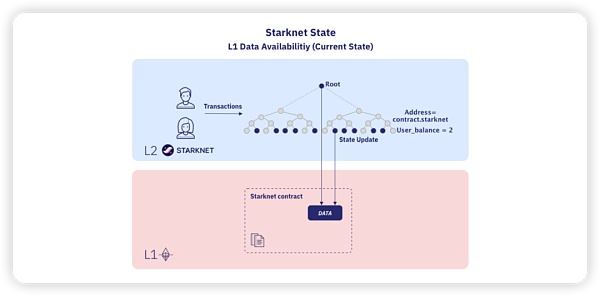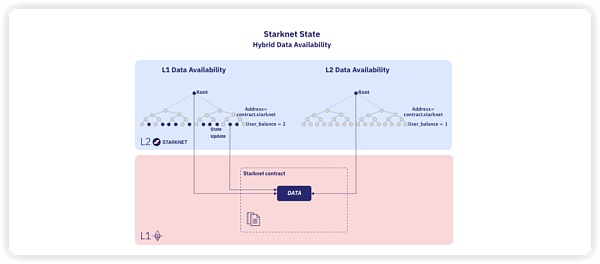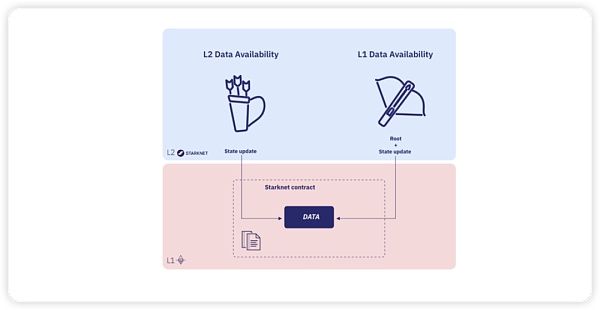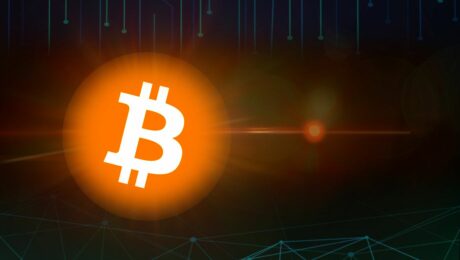Starknet’s Volition Analysis The Perfect Interpretation of Data Security and Cost Control
Starknet's Volition Analysis Perfect Data Security and Cost ControlAbstract
-
Volition will allow developers to adjust data availability on Ethereum (L1) or Starknet (L2), reducing on-chain data and significantly lowering costs.
-
The flexibility of data availability patterns will once again provide developers and users of Starknet with greater freedom to choose the most suitable security level for their specific needs in a cost-effective manner.
-
Volition will be implemented on the testnet in the first quarter of 2024. (Updated)
With the continuous development of Ethereum, the need for scalability and cost reduction becomes increasingly urgent. Therefore, Rollups have emerged as an efficient and scalable solution on Ethereum.
Starknet is an efficiency Rollup created by the creators of STARK Proofs. It operates as a second-layer network, allowing for large-scale computation and reducing computational costs by submitting only the essential data of each transaction to Ethereum (L1) and sharing the verification costs among all transactions within a specific batch using Shared Validators (SHARP).
In the fourth quarter of 2023 (now updated to the first quarter of 2024), Starknet will introduce another important cost reduction measure, addressing a major challenge faced by developers in dealing with transaction costs, namely the high cost of on-chain data on L1.
Among various factors determining transaction costs, the availability of on-chain data alone can account for up to 95% of the average transaction cost. Therefore, finding a way to reduce the cost of on-chain data on L1 can have a significant impact on the overall costs for users and developers. Starknet’s solution is Volition.

Introduction
Currently, Starknet operates in the efficiency Rollup mode, which means that Starknet’s data and state commitments are sent and submitted to Ethereum. With Volition, data can be stored on Starknet L2, allowing developers to optimize their contracts by selecting the data availability mode at the individual storage variable level.
Volition is a technology that allows Starknet developers to freely choose the data availability of their applications or transactions. It’s like they can decide which data needs to be made public and which can remain private. They can flexibly choose between two different data availability modes: one is storing data on Ethereum’s main network (L1), and the other is storing data on Starknet’s second layer (L2). Similarly, this choice can also be passed on to the users of the application.
The implementation of Volition involves dividing Starknet’s data state into two different storage commitment trees. One is for the L1 data availability mode, which means that the data will be published on Ethereum’s main network. The other is for the L2 data availability mode, which means that the data will be updated on Starknet’s second layer and transmitted to the Starknet network. However, only the commitment of the data (i.e., the “root” of the data) will be sent to Ethereum’s main network. This allows developers to make wise choices between data security and costs while maintaining flexibility.

Voluntary Choice
The hierarchical security of data publication determines the level of data availability. L1 and L2. L1 refers to storing data on the main Ethereum network, which has a high level of security because it is protected by Ethereum and the data remains available like other data. L2 refers to storing data on the second layer of Starknet, which is cheaper but has lower security as it is not protected by Ethereum like L1, but the data will be communicated to all nodes on the second layer of Starknet.
Although these necessary measures have been taken to ensure high-level security and availability of L2 data, we acknowledge that for maximum security, L1 data availability (DA) should be your choice to obtain Ethereum-level security. Developers and users need to balance the cost of L2 and the security of L1. We also recommend developers to write contracts that use L2DA so that the contracts can operate normally in the event of a crisis in L2 data availability (e.g., losing L2DA assets). In addition, as we introduce Volition, we recognize that perfecting innovation takes time. Therefore, we will provide long-term availability on the testnet to improve this technology based on community feedback. The introduction of this technology will improve efficiency and development experience as it allows developers to freely choose the level of data publication according to their needs to balance security and cost.
Applications and Uses of Volition
To best illustrate the effectiveness of Volition, let’s look at a few real-world examples.
Imagine that you participate in a highly popular Web3 game built on Starknet, and you successfully bid to purchase a top-tier NFT of a crossbow. Given the importance of this transaction, you may choose the on-chain data availability mode. This will ensure that the ownership of the crossbow is securely recorded on the Ethereum blockchain. Later, you decide to purchase 150 arrow NFTs. Since this purchase has a lower value, you can choose L2 data availability to complete the transaction and save costs.

The same concept applies to high-value decentralized transactions, where the primary task of a DEX is to protect funds and minimize transaction fees. Users can store some funds in their L2 data availability accounts to optimize trading operations. Using funds stored in L2 data storage allows traders to execute a large number of transactions at a reduced cost. When the funds in the L2 data availability account reach a certain amount, the DEX will prioritize security over cost and transfer the funds back to the L1 data availability account. This transfer ensures that most of the funds are securely available on L1.

As seen in these two examples, Volition allows developers and users to choose the data availability mode for each contract, enabling more control and enhancing the user’s trading experience.
When will Volition be launched?
The Volition project is scheduled to launch on the Starknet testnet in the fourth quarter of 2023 (now changed to the first quarter of 2024) and will undergo extensive testing and improvements on the testnet to continually enhance its security and performance based on community feedback. Volition is expected to help many users and dApp developers reduce costs.
In addition, Starknet plans to introduce other data availability modes in the future, such as Adamantium, which is a data availability mode that utilizes a committee for users who want to choose trusted parties for their data availability.
Summary
Volition is an important innovation of Starknet, aiming to address the issues of security and costly on-chain data. It allows data to be stored on the second layer of Starknet, providing developers with opportunities to reduce costs and improve scalability while maintaining the trusted security of Ethereum. This innovation is expected to open up new possibilities for innovative application development.
We will continue to update Blocking; if you have any questions or suggestions, please contact us!
Was this article helpful?
93 out of 132 found this helpful
Related articles
- Top Warehouse Research Report Chain Game Guild Yield Guild Games
- Generative Manufacturing Transforming Code into Physical Objects
- FriendTech Explosive Opportunity Aggregation of Content, Liquidity, and Account Information
- What is Bastion, the encryption product that received a $25 million seed round lead by a16z?
- Evening Must-Read | How AI Reshapes the Cryptocurrency and DeFi World
- LianGuai Morning News | Musk considers charging all Twitter users
- Rollups are competing fiercely. Will a monopolistic Rollup emerge from the competition?






